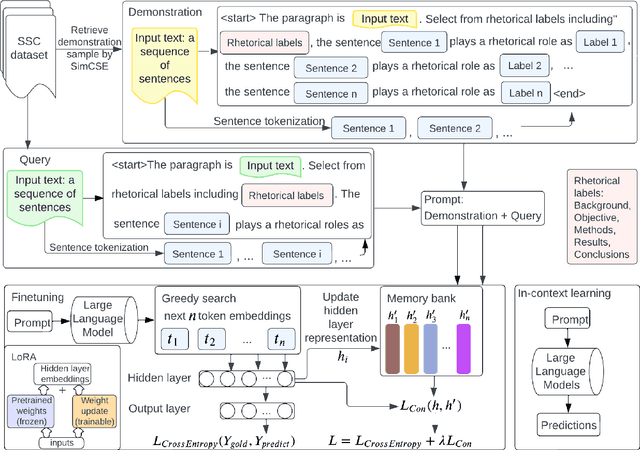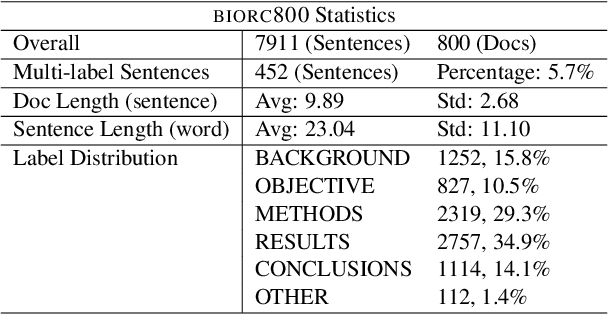Lecheng Zheng
ClimateBench-M: A Multi-Modal Climate Data Benchmark with a Simple Generative Method
Apr 10, 2025Abstract:Climate science studies the structure and dynamics of Earth's climate system and seeks to understand how climate changes over time, where the data is usually stored in the format of time series, recording the climate features, geolocation, time attributes, etc. Recently, much research attention has been paid to the climate benchmarks. In addition to the most common task of weather forecasting, several pioneering benchmark works are proposed for extending the modality, such as domain-specific applications like tropical cyclone intensity prediction and flash flood damage estimation, or climate statement and confidence level in the format of natural language. To further motivate the artificial general intelligence development for climate science, in this paper, we first contribute a multi-modal climate benchmark, i.e., ClimateBench-M, which aligns (1) the time series climate data from ERA5, (2) extreme weather events data from NOAA, and (3) satellite image data from NASA HLS based on a unified spatial-temporal granularity. Second, under each data modality, we also propose a simple but strong generative method that could produce competitive performance in weather forecasting, thunderstorm alerts, and crop segmentation tasks in the proposed ClimateBench-M. The data and code of ClimateBench-M are publicly available at https://github.com/iDEA-iSAIL-Lab-UIUC/ClimateBench-M.
Language in the Flow of Time: Time-Series-Paired Texts Weaved into a Unified Temporal Narrative
Feb 13, 2025Abstract:While many advances in time series models focus exclusively on numerical data, research on multimodal time series, particularly those involving contextual textual information commonly encountered in real-world scenarios, remains in its infancy. Consequently, effectively integrating the text modality remains challenging. In this work, we highlight an intuitive yet significant observation that has been overlooked by existing works: time-series-paired texts exhibit periodic properties that closely mirror those of the original time series. Building on this insight, we propose a novel framework, Texts as Time Series (TaTS), which considers the time-series-paired texts to be auxiliary variables of the time series. TaTS can be plugged into any existing numerical-only time series models and enable them to handle time series data with paired texts effectively. Through extensive experiments on both multimodal time series forecasting and imputation tasks across benchmark datasets with various existing time series models, we demonstrate that TaTS can enhance predictive performance and achieve outperformance without modifying model architectures.
PyG-SSL: A Graph Self-Supervised Learning Toolkit
Dec 30, 2024



Abstract:Graph Self-Supervised Learning (SSL) has emerged as a pivotal area of research in recent years. By engaging in pretext tasks to learn the intricate topological structures and properties of graphs using unlabeled data, these graph SSL models achieve enhanced performance, improved generalization, and heightened robustness. Despite the remarkable achievements of these graph SSL methods, their current implementation poses significant challenges for beginners and practitioners due to the complex nature of graph structures, inconsistent evaluation metrics, and concerns regarding reproducibility hinder further progress in this field. Recognizing the growing interest within the research community, there is an urgent need for a comprehensive, beginner-friendly, and accessible toolkit consisting of the most representative graph SSL algorithms. To address these challenges, we present a Graph SSL toolkit named PyG-SSL, which is built upon PyTorch and is compatible with various deep learning and scientific computing backends. Within the toolkit, we offer a unified framework encompassing dataset loading, hyper-parameter configuration, model training, and comprehensive performance evaluation for diverse downstream tasks. Moreover, we provide beginner-friendly tutorials and the best hyper-parameters of each graph SSL algorithm on different graph datasets, facilitating the reproduction of results. The GitHub repository of the library is https://github.com/iDEA-iSAIL-Lab-UIUC/pyg-ssl.
Can Graph Neural Networks Learn Language with Extremely Weak Text Supervision?
Dec 11, 2024



Abstract:While great success has been achieved in building vision models with Contrastive Language-Image Pre-training (CLIP) over Internet-scale image-text pairs, building transferable Graph Neural Networks (GNNs) with CLIP pipeline is challenging because of three fundamental issues: the scarcity of labeled data and text supervision, different levels of downstream tasks, and the conceptual gaps between domains. In this work, to address these issues, we leverage multi-modal prompt learning to effectively adapt pre-trained GNN to downstream tasks and data, given only a few semantically labeled samples, each with extremely weak text supervision. Our new paradigm embeds the graphs directly in the same space as the Large Language Models (LLMs) by learning both graph prompts and text prompts simultaneously. To accomplish this, we improve state-of-the-art graph prompt method, and then propose the first graph-language multi-modal prompt learning approach for exploiting the knowledge in pre-trained models. Notably, due to the insufficient supervision for fine-tuning, in our paradigm, the pre-trained GNN and the LLM are kept frozen, so the learnable parameters are much fewer than fine-tuning any pre-trained model. Through extensive experiments on real-world datasets, we demonstrate the superior performance of our paradigm in few-shot, multi-task-level, and cross-domain settings. Moreover, we build the first CLIP-style zero-shot classification prototype that can generalize GNNs to unseen classes with extremely weak text supervision.
Multi-label Sequential Sentence Classification via Large Language Model
Nov 23, 2024



Abstract:Sequential sentence classification (SSC) in scientific publications is crucial for supporting downstream tasks such as fine-grained information retrieval and extractive summarization. However, current SSC methods are constrained by model size, sequence length, and single-label setting. To address these limitations, this paper proposes LLM-SSC, a large language model (LLM)-based framework for both single- and multi-label SSC tasks. Unlike previous approaches that employ small- or medium-sized language models, the proposed framework utilizes LLMs to generate SSC labels through designed prompts, which enhance task understanding by incorporating demonstrations and a query to describe the prediction target. We also present a multi-label contrastive learning loss with auto-weighting scheme, enabling the multi-label classification task. To support our multi-label SSC analysis, we introduce and release a new dataset, biorc800, which mainly contains unstructured abstracts in the biomedical domain with manual annotations. Experiments demonstrate LLM-SSC's strong performance in SSC under both in-context learning and task-specific tuning settings. We release biorc800 and our code at: https://github.com/ScienceNLP-Lab/LLM-SSC.
Online Multi-modal Root Cause Analysis
Oct 13, 2024Abstract:Root Cause Analysis (RCA) is essential for pinpointing the root causes of failures in microservice systems. Traditional data-driven RCA methods are typically limited to offline applications due to high computational demands, and existing online RCA methods handle only single-modal data, overlooking complex interactions in multi-modal systems. In this paper, we introduce OCEAN, a novel online multi-modal causal structure learning method for root cause localization. OCEAN employs a dilated convolutional neural network to capture long-term temporal dependencies and graph neural networks to learn causal relationships among system entities and key performance indicators. We further design a multi-factor attention mechanism to analyze and reassess the relationships among different metrics and log indicators/attributes for enhanced online causal graph learning. Additionally, a contrastive mutual information maximization-based graph fusion module is developed to effectively model the relationships across various modalities. Extensive experiments on three real-world datasets demonstrate the effectiveness and efficiency of our proposed method.
Fair Anomaly Detection For Imbalanced Groups
Sep 17, 2024



Abstract:Anomaly detection (AD) has been widely studied for decades in many real-world applications, including fraud detection in finance, and intrusion detection for cybersecurity, etc. Due to the imbalanced nature between protected and unprotected groups and the imbalanced distributions of normal examples and anomalies, the learning objectives of most existing anomaly detection methods tend to solely concentrate on the dominating unprotected group. Thus, it has been recognized by many researchers about the significance of ensuring model fairness in anomaly detection. However, the existing fair anomaly detection methods tend to erroneously label most normal examples from the protected group as anomalies in the imbalanced scenario where the unprotected group is more abundant than the protected group. This phenomenon is caused by the improper design of learning objectives, which statistically focus on learning the frequent patterns (i.e., the unprotected group) while overlooking the under-represented patterns (i.e., the protected group). To address these issues, we propose FairAD, a fairness-aware anomaly detection method targeting the imbalanced scenario. It consists of a fairness-aware contrastive learning module and a rebalancing autoencoder module to ensure fairness and handle the imbalanced data issue, respectively. Moreover, we provide the theoretical analysis that shows our proposed contrastive learning regularization guarantees group fairness. Empirical studies demonstrate the effectiveness and efficiency of FairAD across multiple real-world datasets.
Towards Multi-view Graph Anomaly Detection with Similarity-Guided Contrastive Clustering
Sep 15, 2024Abstract:Anomaly detection on graphs plays an important role in many real-world applications. Usually, these data are composed of multiple types (e.g., user information and transaction records for financial data), thus exhibiting view heterogeneity. Therefore, it can be challenging to leverage such multi-view information and learn the graph's contextual information to identify rare anomalies. To tackle this problem, many deep learning-based methods utilize contrastive learning loss as a regularization term to learn good representations. However, many existing contrastive-based methods show that traditional contrastive learning losses fail to consider the semantic information (e.g., class membership information). In addition, we theoretically show that clustering-based contrastive learning also easily leads to a sub-optimal solution. To address these issues, in this paper, we proposed an autoencoder-based clustering framework regularized by a similarity-guided contrastive loss to detect anomalous nodes. Specifically, we build a similarity map to help the model learn robust representations without imposing a hard margin constraint between the positive and negative pairs. Theoretically, we show that the proposed similarity-guided loss is a variant of contrastive learning loss, and how it alleviates the issue of unreliable pseudo-labels with the connection to graph spectral clustering. Experimental results on several datasets demonstrate the effectiveness and efficiency of our proposed framework.
LEMMA-RCA: A Large Multi-modal Multi-domain Dataset for Root Cause Analysis
Jun 08, 2024



Abstract:Root cause analysis (RCA) is crucial for enhancing the reliability and performance of complex systems. However, progress in this field has been hindered by the lack of large-scale, open-source datasets tailored for RCA. To bridge this gap, we introduce LEMMA-RCA, a large dataset designed for diverse RCA tasks across multiple domains and modalities. LEMMA-RCA features various real-world fault scenarios from IT and OT operation systems, encompassing microservices, water distribution, and water treatment systems, with hundreds of system entities involved. We evaluate the quality of LEMMA-RCA by testing the performance of eight baseline methods on this dataset under various settings, including offline and online modes as well as single and multiple modalities. Our experimental results demonstrate the high quality of LEMMA-RCA. The dataset is publicly available at https://lemma-rca.github.io/.
Heterogeneous Contrastive Learning for Foundation Models and Beyond
Mar 30, 2024Abstract:In the era of big data and Artificial Intelligence, an emerging paradigm is to utilize contrastive self-supervised learning to model large-scale heterogeneous data. Many existing foundation models benefit from the generalization capability of contrastive self-supervised learning by learning compact and high-quality representations without relying on any label information. Amidst the explosive advancements in foundation models across multiple domains, including natural language processing and computer vision, a thorough survey on heterogeneous contrastive learning for the foundation model is urgently needed. In response, this survey critically evaluates the current landscape of heterogeneous contrastive learning for foundation models, highlighting the open challenges and future trends of contrastive learning. In particular, we first present how the recent advanced contrastive learning-based methods deal with view heterogeneity and how contrastive learning is applied to train and fine-tune the multi-view foundation models. Then, we move to contrastive learning methods for task heterogeneity, including pretraining tasks and downstream tasks, and show how different tasks are combined with contrastive learning loss for different purposes. Finally, we conclude this survey by discussing the open challenges and shedding light on the future directions of contrastive learning.
 Add to Chrome
Add to Chrome Add to Firefox
Add to Firefox Add to Edge
Add to Edge